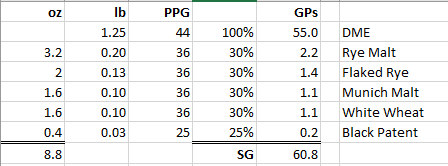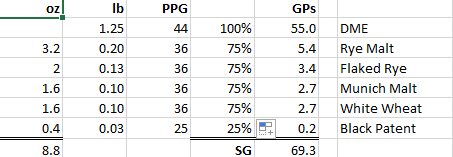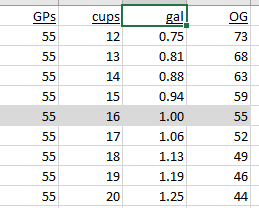Another idea is amylase enzyme to cut the FG down
You are using an out of date browser. It may not display this or other websites correctly.
You should upgrade or use an alternative browser.
You should upgrade or use an alternative browser.
Which Ale yeast will eat the big sugars?
- Thread starter polutj
- Start date

Help Support Homebrew Talk - Beer, Wine, Mead, & Cider Brewing Discussion Forum:
This site may earn a commission from merchant affiliate
links, including eBay, Amazon, and others.
BrewnWKopperKat
ʘ‿ʘ
A question: did you take a FG measurement for the hoppy rye?The hoppy rye looks to have an OG of 1.060
From the recipe, the hoppy rye lists an OG of 56.
1.25 lbs of DME (OG 44) in 1 gal of water is OG 55.
The recipe includes a number malts that need to be mashed as well as a small amount of Black Patent malt. The instructions call for a 20 minute steep at 155F. That's in the "short and shoddy" range for mashing times. Efficiency may be as low as 30% or as high as 75%. Let's use the low/high extremes to create a range of OG values.
| at 30% efficiency - OG 60-ish | at 75% efficiency: OG 70-ish |

| 
|
The recipe estimates 40 IBUs. The recipe provides timings, but no AA values for each of the hops. So we'll work with 40 IBUs.
At this point, we can calculate BU:GU ratios for OG 55, 60, 65, and/or 70, then compare the result to our individual tastes.
I did take the FG but the pages are now glued together due to my coffee mishap. The OG I hit for the hoppy rye was 1.060 (I think. The page is pretty hard to read now). I brewed a decent amount (for a newbie) of all grain brews and have never tasted this. I have used windsor a fair amount and so I am also familiar with underattenuation, which I don't always mind. I can't figure out why the syrupy taste. On the assumption the FG wasn't as low as it should have been, I have overshot OG and had all grain beers land in and around 1.015-1.25 FG, once in the 1.030's when I didn't mean to, and none taste like the DME-based beers do in these recipes. Heck, my beers don't even taste like that before I add yeast or when I take my first gravity readings.A question: did you take a FG measurement for the hoppy rye?
From the recipe, the hoppy rye lists an OG of 56.
1.25 lbs of DME (OG 44) in 1 gal of water is OG 55.
The recipe includes a number malts that need to be mashed as well as a small amount of Black Patent malt. The instructions call for a 20 minute steep at 155F. That's in the "short and shoddy" range for mashing times. Efficiency may be as low as 30% or as high as 75%. Let's use the low/high extremes to create a range of OG values.
at 30% efficiency - OG 60-ish at 75% efficiency: OG 70-ish View attachment 816511 View attachment 816512
The recipe estimates 40 IBUs. The recipe provides timings, but no AA values for each of the hops. So we'll work with 40 IBUs.
At this point, we can calculate BU:GU ratios for OG 55, 60, 65, and/or 70, then compare the result to our individual tastes.
Last edited:
BrewnWKopperKat
ʘ‿ʘ
@Christoff : as I was looking at the recipe process notes, I did see this:
which is both good (step 11 'tops up' to 1 gal) and maybe not so good (starting at 1 gal and boiling down to maybe 3 quarts over 60 min).
Generally, one accounts for the water boiled off by including it at the start of the boil. In the above example, I would start with 1.25 gal of water, boil off a quart, and end up with 1 gal of wort.
FWIW: SG and wort volumes: With 1 gal batches, an extra (or missing) cup of water is about 3 GPs.

| ... |
which is both good (step 11 'tops up' to 1 gal) and maybe not so good (starting at 1 gal and boiling down to maybe 3 quarts over 60 min).
Generally, one accounts for the water boiled off by including it at the start of the boil. In the above example, I would start with 1.25 gal of water, boil off a quart, and end up with 1 gal of wort.
FWIW: SG and wort volumes: With 1 gal batches, an extra (or missing) cup of water is about 3 GPs.

5 gal brewers: please "stand down". Us small batch brewers have the tools and techniques to make volume adjustments in the half cup range. BrewnWKopperKat
ʘ‿ʘ
Water and brand of DME (or LME) may be a consideration.I have had all grain beers land in and around 1.015-1.25 FG, once even in the 1.030's, and none taste like the DME-based beers do in these recipes.
Are you using distilled/RO water or tap water (if tap, do you know the key ion PPMs?).
Different brands of DME will have (slghtly?) different mineral content. If you are using Briess, can you try Muntons?
eta: also, for my tastes, starting in the OG 55 range, I will start substituting sugar for DME.
I used my well water for these kits. I have recently started adding gypsum and CaCl to my tap water (which seems to have helped other issues) so I will try that when April's comes in. I want to say it is Briess' DME but can't honestly remember off the top of my headWater and brand of DME (or LME) may be a consideration.
Are you using distilled/RO water or tap water (if tap, do you know the key ion PPMs?).
Different brands of DME will have (slghtly?) different mineral content. If you are using Briess, can you try Muntons?
BrewnWKopperKat
ʘ‿ʘ
Thanks (and no worries on the brand of DME).I used my well water for these kits. I have recently started adding gypsum and CaCl to my tap water so I will try that when April's comes in. I want to say it is Briess' DME but can't honestly remember off the top of my head
Without knowing the mineral content (Ca, Mg, Na, Cl, S04) content of your well water, I'll suggest adding a small amount of either (but not both) of gypsum (hoppy styles) or CaCl (malty styles). For my tastes, distilled water, and traditional beer styles, it's in the 0.25 to 0.50 gram per gallon range.I have recently started adding gypsum and CaCl to my tap water so I will try that when April's comes in.
VikeMan
It ain't all burritos and strippers, my friend.
- Joined
- Aug 24, 2010
- Messages
- 5,874
- Reaction score
- 5,999
There are no yeast that will “eat” any sugars larger than the monosaccharides that are created during the mashing process at the correct temperature(s).
I don't think you meant to say monosaccharides here. Sucrose, Maltose and Maltotriose are not monosaccharides, and they are fermented by most strains. And there are even longer dextrins that can be used by diastaticus strains.
I have my Ward’s report on another thread. Someone recommended both. I’m happy to upload it again as I don’t remember the numbers off the top of my head. I’ll have to upload it later.Thanks (and no worries on the brand of DME).
Without knowing the mineral content (Ca, Mg, Na, Cl, S04) content of your well water, I'll suggest adding a small amount of either (but not both) of gypsum (hoppy styles) or CaCl (malty styles). For my tastes, distilled water, and traditional beer styles, it's in the 0.25 to 0.50 gram per gallon range.
BrewnWKopperKat
ʘ‿ʘ
Looks like it might be here: What is the best all-around salt additions for Distilled waterI have my Ward’s report on another thread.
Most of the key numbers are low.
For a next batch with a DME-based recipe, consider
- using distilled or reverse osmosis water (but not spring or store bought drinking water)
- replacing about 10% of the DME with sugar,
- steeping in a low SG wort (rather than just water) to help manage pH of the steep (/1/, /2/).
- An SG 10-ish wort is suggested in /1/.
- For an OG 55 wort (1.25 lb of DME) in 1 gal of water) SG 11 is 0.25 lb of DME
- -----
- /1/ Methods of Modern Homebrewing, p 18.
- /2/ How to Brew, 4e, p 12
BrewnWKopperKat
ʘ‿ʘ
@Christoff : there's a loosely related topic (link) where people are troubleshooting an all-grain pilsner recipe that is coming out 'sweet'. Many of the ideas mentioned there are also mentioned here, but there is some additional information that you may be interested in.
Yup thats the one. I figured the dme would have just provided enough of the mineral content that that would have been an issue but I'll definitely try RO water next time.Looks like it might be here: What is the best all-around salt additions for Distilled water
Most of the key numbers are low.
For a next batch with a DME-based recipe, consider
- using distilled or reverse osmosis water (but not spring or store bought drinking water)
- replacing about 10% of the DME with sugar,
- steeping in a low SG wort (rather than just water) to help manage pH of the steep (/1/, /2/).
- An SG 10-ish wort is suggested in /1/.
- For an OG 55 wort (1.25 lb of DME) in 1 gal of water) SG 11 is 0.25 lb of DME
- -----
- /1/ Methods of Modern Homebrewing, p 18.
- /2/ How to Brew, 4e, p 12
I forgot to mention that I steep the grains for ~30 min in the wort prior to bringing to a boil for the hops (How to brew pg 56). That was the first book I read and the first couple brews were extract. I can't for the life of me remember what they tasted like.
Thanks for the link above. I'll take a look
I was about to mention Belle Saison yeast. It's a diastaticus. The only diastaticus yeast that I've used is Jovaru, and I like it but sure hope it hasn't contaminated all my equipment.Someone correct me if this is wrong, but wouldn't a diastaticus yeast do the job for OP?
ISTM that sometimes when you can't figure out what went wrong it just might mean that nothing went wrong. Let's say you brew a recipe that calls for a yeast that attenuates in the 80% range. You hit the expected OG and FG exactly, but you think it has too much residual sweetness. You could try to "fix" it with enzymes or a diastatic strain. Or you could just brew a different style next time.
This is not to say that one should always just shrug everything off of course. If your OG was a few points low and your FG was a few points high there might really be something that needs fixing, even if each of the differences might seem small enough to ignore at first glance.
This is not to say that one should always just shrug everything off of course. If your OG was a few points low and your FG was a few points high there might really be something that needs fixing, even if each of the differences might seem small enough to ignore at first glance.
BrewnWKopperKat
ʘ‿ʘ
Well, not exactly but sort of.There are no yeast that will “eat” any sugars larger than the monosaccharides that are created during the mashing process at the correct temperature(s).
So, what is Saccharomyces cerevisiae var diastaticus (S.diastaticus)?
S. diastaticus is a variant of Saccharomyces cerevisiae that contains the STA1 gene. It is a well-known yeast strain used in the brewing industry that releases an enzyme, called glucoamylase, that breaks down dextrins (long-chain carbohydrates) outside of the yeast cell into smaller sugars, which it can then continue to metabolize. These strains are commonly used due to their sugar metabolism abilities and the desirable flavors that are produced. These are most often seen as saison strains, but also found in other yeast strains like that of Sacch Trois. Diastaticus has caused some recent troubling concerns in the brewing industry, due to cross-contamination, leading to unexpected over-attenuation.Similar threads
- Replies
- 13
- Views
- 489
- Replies
- 11
- Views
- 392
- Replies
- 2
- Views
- 264
Latest posts
-
-
-
-
-
-
Closed pressure transfer from a plastic fermentation bucket
- Latest: cactusgarrett
-
-


